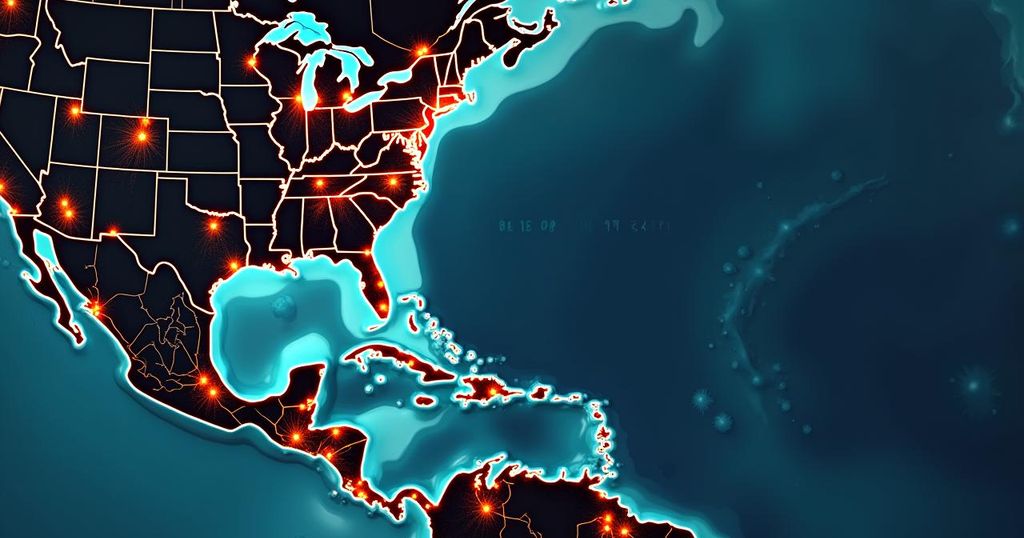Hurricane Milton: Projected Path and Potential Impact on Florida

Hurricane Milton is a Category 4 hurricane in the Gulf of Mexico, expected to make landfall in Florida with severe rainfall, storm surges, and damaging winds. It follows Hurricane Helene, which caused significant destruction and fatalities. Meteorologists warn of dangerous conditions including flooding as rainfall continues. This season could see 17 to 25 storms, with up to seven becoming major hurricanes.
Hurricane Milton has emerged as a formidable Category 4 hurricane in the Gulf of Mexico, having been downgraded from Category 5 overnight. Predictions indicate that Hurricane Milton may make landfall in the western region of the Florida peninsula, potentially causing severe weather conditions including substantial rainfall, ocean surges, and damaging winds. As is often the case with hurricanes, the repercussions may extend significantly to the north and south of the storm’s eye. The National Hurricane Center has warned of potential flooding in Florida due to heavy rainfall expected to persist until the arrival of Milton on Wednesday. Should Hurricane Milton maintain its current path, it would represent the second hurricane to impact Florida in a span of less than two weeks, following Hurricane Helene, which made landfall as a Category 4 and resulted in devastating storm surges along Florida’s Gulf Coast. Helene has tragically been linked to over 220 fatalities across its trajectory from Florida to Virginia. Hurricanes form and intensify when tropical cyclones in the Atlantic encounter conducive conditions. Meteorologists closely monitor a cyclone’s wind speed, which categorizes it according to intensity. When wind speeds reach 39 mph, it is classified as a tropical storm and designated a name; at 74 mph, it escalates to a Category 1 hurricane, with classifications continuing up to Category 5. These classifications assist authorities in assessing potential risks and damages and facilitate timely warnings regarding the severe winds, waves, rainfall, and flooding expected upon landfall. Encountering tropical storm-force winds presents a significant danger, as hurricane-force winds can devastate structures and propel debris dangerously. Additionally, these winds can drive seawater inland, leading to elevated water levels termed storm surge—the primary cause of hurricane-related fatalities in the United States, as reported by the National Weather Service. The risk of large, destructive waves also poses a threat to individuals and properties. As the storm progresses inland, the danger of flooding emerges as a critical concern. Hurricanes typically generate over six inches of rain, which can overwhelm drainage systems and saturate ground absorption, resulting in rapid flash floods that may persist for several days post-storm. Historically, hurricane season peaks around mid-September, and the National Oceanic and Atmospheric Administration has warned that this season may be among the most severe experienced in decades. Meteorologists predict a total of 17 to 25 tropical storms this year, with estimates of four to seven developing into major hurricanes.
Hurricane Milton represents a significant meteorological event, being the latest storm in the Gulf of Mexico. Understanding hurricane formation and the potential hazards associated with tropical systems is crucial, particularly during a season projected to be notably severe. This article underscores the importance of preparation and awareness during hurricane season, specifically highlighting Hurricane Milton’s anticipated impact on Florida following the recent devastation caused by Hurricane Helene.
In summary, Hurricane Milton, categorized as a Category 4 storm, poses a serious threat to Florida, with landfall likely resulting in severe rainfall, storm surges, and damaging winds. Historical trends indicate that hurricane seasons can be particularly devastating, amplifying concerns about flooding and unpredictable weather patterns. Preparedness and resilience are essential as communities brace for the impending storm.
Original Source: www.washingtonpost.com






